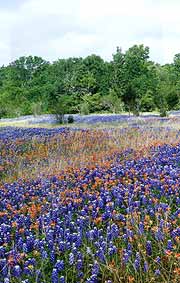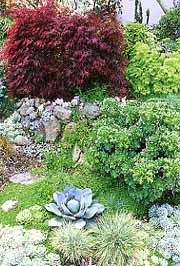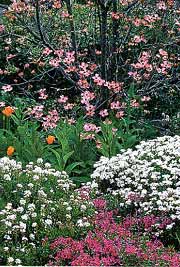Growing Sun-Loving Plants: Lessons From Nature

The more you know about the plants in your garden, the better you can accommodate their needs. The first step in knowing a plant is to find out where it grows in the wild. In nature, evolution has adapted plants to a variety of sun exposures and soil and moisture conditions. If a plant thrives in a particular spot in nature, it is likely to thrive under similar conditions in your garden.
Most of the plants we grow in our sunny borders evolved in grasslands, on rocky mountainsides, and in sunny marshes around the world. North America's prairies have given us such beautiful plants as blazing stars (Liatris), sunflowers (Helianthus), and milkweeds, including butterfly weed (Asclepias tuberosa). Yarrows (Achillea), calamints (Calamintha), and meadow sage (Salvia nemorosa) come from the meadows of Europe; peonies from southeastern Europe, the Caucasus, Siberia, Tibet, and China; balloon flowers (Platycodon) from wet meadows in Japan and eastern China; and Cape fuchsia (Phygelius) from stream banks in the mountains of southern Africa. The soils differ, the moisture levels are diverse, and the climates vary, but what each of these native plant communities have in common is an abundance of sunshine.
If you are new to gardening, observe which sun-loving plants thrive in your area by visiting nature preserves and other wild habitats. Notice, too, how nature combines these species into various plant associations or communities, from deserts and dry upland meadows to wet roadside ditches. Make these natural communities the foundation of your plant combinations, and your garden will be both beautiful and easy to maintain.
Degrees of Sunshine
Plants for a sunny Border grow best with a minimum of 10 to 12 hours a day of direct sun in midsummer. The precise amount of sunshine required will vary, depending on the region and the particular plant. Not all plants are as adaptable as the ubiquitous daylily (Hemerocallis species) or Border phlox (Phlox paniculata), which grow in nature in sunny woodland glades and in meadows. What's more, full sun in Minnesota is different from full sun in Mississippi. In Minnesota the sun is less intense, but in summer it stays light longer than in Mississippi. While balloon flower demands full sun in most gardens, in the deep South it will grow happily in partial shade. Success depends on choosing the best plants for your region. Check the Native Habitat heading in each plant entry in the chapter entitled "Encyclopedia of Sun-Loving Plants" for information on where the species grows in the wild. If it is native to an area with a climate and growing conditions similar to yours, chances are the plant will do well for you.
Moisture Conditions
Native plant communities are classified by ecologists into three broad categories based on their moisture conditions: xeric or dry, hydric or wet, and mesic or moist. These moisture regimes are determined by both soil type and position in the landscape. In general, dry soils occur in upland areas or on sharply draining slopes. They are gravelly, sandy, or sandy loam soils. Hydric sites, including swales and other low spots where water collects, can be inundated during winter and spring. The soils in such areas tend to be heavy clays or highly organic peats. Mesic areas are seldom inundated by water, and the soils typically are loams containing roughly equal portions of sand, silt, and clay. Rich, loamy soil is the kind gardeners traditionally have considered ideal, because they are neither too wet nor too dry for the most common garden plants.
An Easy Way to Improve Your Soil
Almost any kind of soil can benefit from the addition of organic matter in the form of humus. Humus is decayed organic matter that is very fertile and has exceptional water-holding ability. Compost and well-composted manure are sources of humus.
An easy way to amend the soil is to add a layer of organic matter 4 to 6 inches deep over the entire planting bed. Incorporate it thoroughly to a depth of 10 to 12 inches. Break the soil up with a shovel or spading fork. Continue digging or spading until all large lumps of soil are broken up and the compost or manure is thoroughly mixed with the existing soil.
If the soil contains a large percentage of clay, add both organic matter and sand or fine gravel. Break the soil up as described above, then spread 2 inches each of compost and sharp builder's sand over the planting bed. Incorporate to a depth of 12 inches, mixing thoroughly with the soil.
Once all clods and clumps are broken up and the organic matter is thoroughly incorporated, smooth out the surface of the bed. Use a metal garden rake to even out any hills or dips. Remove any roots or other debris. Your site is now ready for planting.
Different plants are adapted to these various moisture conditions. Determine which type of soil you have and choose plants accordingly. Plants in "Encyclopedia of Sun-Loving Plants" are organized according to their moisture preferences.
Dealing With Dry Soil
A perpetually dry spot may seem like an impossible challenge, but it can be transformed into a colorful oasis. Many popular perennials such as lavenders (Lavandula), purple coneflowers (Echinacea), yarrows (Achillea), yuccas, daylilies (Hemerocallis), and pinks (Dianthus) thrive in dry soil.
If your garden is high and sloping, with sandy or gravelly soil, or a sandy spot near the sea, water will quickly drain downhill or evaporate in the wind. The addition of organic matter will help the soil retain water. If the soil is solid clay, the addition of coarse sand or fine gravel, such as decomposed granite or chicken grit, along with organic matter will help keep the soil open so water soaks in rather than runs off.
To succeed in gardening in such an environment, you need plants that will thrive under the existing conditions. In prairies, on sunny mountainsides, and on sand dunes, as well as in deserts, a wealth of beautiful plants grow that will thrive in a garden like yours.
Just by looking at a plant, experienced gardeners can get a pretty good idea of whether or not it is adapted to dry soils in full sun. The foliage is one key to where the plant thrives in nature. In areas where summers are hot, dry, or both, plants have small leaves, which are very efficient at producing food and lose relatively little moisture to transpiration. The more moisture a plant gets, the larger its leaves can be, but plants adapted to full sun seldom have leaves as large as those of shade-loving plants, such as hosta. If the leaves are waxy or fleshy, such as those of sedum, they are designed to hold water. Silvery or hairy leaves such as those of catmints (Nepeta) are also adapted to dry, sunny areas because the hairs reflect light and act like insulation, keeping the plant from overheating and wilting.
Another way plants cope with sun is to store moisture in their roots or stems. If a plant grows from a bulb, corm, tuber, or tuberous root, chances are it is sun- and drought-tolerant. Perennials with deep taproots are also good choices. Think of tap-rooted false indigo (Baptisia australis) on a dry roadside or the thick rhizome of a bearded iris, designed to survive the long, dry Mediterranean summer.

Plants with silvery, waxy, fleshy, or small leaves are usually adapted to dry soils. The agave and succulents in the Border at right require little water.
Mulch is a great help in conserving moisture on dry soils. Choose a porous mulch so that water will quickly filter through and enter the soil rather than run off. Don't add too much, though, as plants adapted to dry conditions are easily smothered and will rot if they're covered with soggy mulch. About one inch of composted bark or shredded leaves is sufficient.
Making the Most of Moisture
If you have a low sunny spot that does not drain well, a soggy streamside or a pond, you can grow plants that demand constant moisture. Wet soil allows you to grow a variety of bold, beautiful plants—like queen-of-the-prairie (Filipendula rubra)—that will not otherwise thrive in most gardens. Astilbes and ligularias also thrive in sun if their feet are wet. Hydric gardens are lush and colorful, and many moisture-loving plants like cardinal flower (Lobelia cardinalis) and joe-pye weed (Eupatorium) are magnets for butterflies.
Naturally wet soil is often high in organic matter and very fertile. A low spot in your yard may be wet because a clay hardpan is keeping moisture from draining away. If the soggy spot is solid clay, adding some organic matter like compost will help your garden grow. Digging in mucky soil is difficult, so choose a dry spell to do soil preparation. If the spot is always wet, spread a 10- to 12-inch layer of compost over the existing soil, and plant right into the compost.
Plant Layers
Native plant communities are arranged in layers to create a complex but seamless whole. Layers in a forest are easy to see, from the tallest trees down to the ferns and tiny mosses on the forest floor. Grasslands and other sunny plant communities are also layered. Small wildflowers and native bulbs bloom early and are topped by later-blooming wildflowers and grasses, which form the highest layer unless shrubs are present. Look at nature's layering and use these vertical patterns to add harmony and complexity to your garden.
Sunny Borders for Every Region
The Northeast
In this region, bedrock is close to the surface, and soils are generally thin and highly acidic. The gardening season is short, except near the coast, with USDA hardiness zones ranging from 3 to 7. This means gardening can be a challenge, especially in the more northern areas. The advantages of gardening in northern latitudes or at higher elevations in mountainous regions are low humidity and delightfully cool summer days. Cool temperatures mean that moisture evaporates slowly, so supplemental watering is only necessary during extended dry spells. Plants grow more slowly when temperatures are cool, producing stronger, less succulent stems. Strong growth is more resistant to damage from insects and diseases. Towering delphiniums and hollyhocks (Alcea species), huge fragrant peonies, glorious asters, and disease-free roses are the pride of northern gardeners, as are the fiery leaves of maples in autumn.
The Mid-Atlantic
By and large, eastern North America is dominated by deciduous forests, but meadows and old fields (mixtures of grasses, perennials, and shrubs), ablaze with color in summer, are found in breaks in the forest and on sandy coastal plains.
Gardeners need to choose heat- and disease-resistant perennials that tolerate the high temperatures and humidity of a mid-Atlantic summer, but in general they are fortunate, as plants thrive thanks to mild winters and long, balmy autumns. This area covers Zones 5 to 7, depending on altitude and distance from the ocean. Soils are mostly clay loams or sandy loams, and though fertile, they usually need organic matter to increase moisture retention. In this temperate region, many perennials from both north and south can be grown successfully together, making exciting gardens that are colorful from late winter until October or November.
The Southeast
The Southeast is characterized by sandy plains near the coast, with richer and moister clay-based soils farther inland. Though clay retains moisture, it may shrink and crack as it dries, breaking brittle roots. Gardeners in this area need to add large quantities of organic matter to the soil and use mulch to retain moisture.
In summer, plants must endure soaring daytime temperatures, sultry humidity, and nights that often feel no cooler than the daytime. Fungal and bacterial diseases can be a real problem; choose resistant varieties when possible and space plants properly to encourage healthy air circulation. However, late winter and spring are glorious, with colorful bulbs and flowering shrubs, and the long fall is full of blooming salvias and asters.
In Zones 7 to 9, native meadow flowers as well as old-fashioned pass-along plants like scarlet rose mallow (Hibiscus coccineus) have been grown for generations. Many tropical plants, such as cannas and bananas (Musa species), can be overwintered in the ground here, making stunning gardens when mixed with more traditional perennials.

Native plant communities are arranged in layers to create a complex but seamless whole. Imitate nature by integrating shrubs, such as the flowering dogwood, above, into your perennial border.
The Midwest and Plains States
The vast region between the Appalachian range and the Rocky Mountains was once dominated by prairies. The easternmost portion of the prairie province has deep, rich soils and ample rainfall, making for luxuriant gardens. As you move west, precipitation decreases. Areas that lie in the rain shadow of the Rockies receive less than 16 inches of rain per year, so garden plants there must be chosen carefully.
The intense winter cold (Zones 3 to 5), summer heat, and periodic drought in the region produce stressful conditions for plants. The good news is that winter snows protect plants from the worst of the cold. Preparing the soil well and choosing regionally native or adapted species with exceptional hardiness are mandatory for success, especially where the soil is thin and dry. A protective mulch of chopped leaves can help the garden through the winter, and it's imperative in areas where you cannot count on consistent snow cover.
The Southwest and Southern California
The mild summer and winter temperatures of the Southwest and southern California make it possible to grow a variety of plants from various regions. Days are sunny and dry, and nights are cool. Most of the rain falls in winter, leaving a long season of little or no rainfall. Plants must be able to endure drought.
Many traditional perennial garden plants do poorly here despite the cool summers because the winters are not cold enough to satisfy their dormancy requirements. Native plants such as beard tongue (Penstemon) and yucca, as well as those from Mediterranean climates, such as catmints, sages (Salvia species), and lavenders, perform best. Succulents and cacti are good choices for the sunny border, as are woolly-leafed plants that may rot in wetter areas of the country.
The Pacific Northwest
Gardeners in this large region encompassing Zones 6 to 8 generally enjoy cool summers, ideal for growing perennials. Coastal areas have mild winters as well, making them a gardening paradise—the perfection so admired in English gardening books is most attainable here. Autumn, winter, and spring are the seasons with the highest rainfall.
The northern Pacific coast receives 50 to 100 inches of rain a year, giving rise to a lush and productive temperate rainforest. Clay-based soils are usually shallow and acidic, so good soil preparation may be necessary. Mountainous regions are colder but offer wonderful possibilities for gardening with hardy, drought-tolerant plants.


